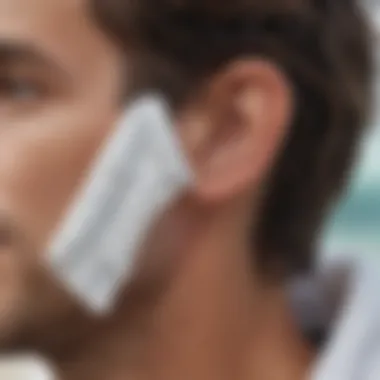Top Methods to Effectively Clear Water from Ears


Intro
Water trapped in the ear — it can be an annoying and uncomfortable experience. Whether from swimming, showering, or just a rainy day, having water stuck in your ear can lead to a host of issues, like muffled hearing or even infections if not addressed properly. Surprisingly, many folks overlook this typical issue, thinking it will sort itself out in no time. However, understanding effective methods for getting rid of water from the ear can make all the difference in not just relieving discomfort but also preventing further complications.
Common Causes of Water Accumulation
In our fast-paced lives, it's easy to understand how water can find its way into the ear. Here are a few common scenarios:
- Swimming: One of the leading causes; the last thing you want after a refreshing dip is that nagging feeling of water stuck in your ear.
- Showering: Often, while washing your hair, water can inadvertently seep into your ear canal.
- Excessive Sweat: For those who lead an active lifestyle, sweat can collect in the ears when it's hot and humid.
Recognizing these causes will help in both addressing the immediate discomfort and implementing preventive strategies moving forward.
Techniques for Safely Removing Water from the Ear
Here, we’ll explore some of the best-known techniques people use to safely drain water from their ears, each with its own effectiveness and potential risks.
The Gravity Method
One of the simplest methods to remove water from the ear is utilizing gravity. Here’s how:
- Tilt your head to the side, so the affected ear faces down.
- Pull your earlobe gently, which helps to open up the ear canal.
- You can also jump lightly on the opposite foot to encourage the water to flow out.
This method is straightforward but can be surprisingly effective for many.
The Vacuum Technique
Another option involves creating a vacuum seal. This technique is often utilized by swimmers:
- Tilt your head sideways.
- Place your palm over your ear, creating a snug fit.
- Gently push your palm in and out, creating a suction effect.
This may take a few tries, but some find it very effective in dislodging troublesome water.
Using Heat
Sometimes, warmth can help expedite the evaporation process:
- Grab a warm compress or a heating pad.
- Hold it against the affected ear for a few minutes.
- The heat might help loosen any trapped water, facilitating its exit.
Be cautious not to overheat the compress, as sensitive skin can be affected.
Remember, these techniques are generally safe, but they are not a substitute for professional medical advice when pain or prolonged blockage occurs.
Preventive Measures
To steer clear of future drownings in ear water, consider these practical tips:
- Use earplugs when swimming or taking showers.
- Shake your head out gently after swimming to help dislodge water.
- Consider a headband if you're swimming laps to keep water out of your ears.
By implementing these preventive strategies, you can minimize the chances of water sticking around in your ears.
Final Thoughts
Understanding Ear Water Accumulation
Water trapped in the ear can be more than just an annoying sensation; it can lead to discomfort and even health issues if not properly managed. Understanding how water accumulates in the ear, and the anatomy of the ear itself, is key to addressing the problem effectively. This knowledge not only helps in effective removal techniques but also plays a role in preventing future occurrences.
Anatomy of the Ear
Outer Ear Structure
The outer ear, consisting of the pinna and ear canal, serves a vital role in capturing sounds. Its shape directs sound waves toward the middle ear. A noteworthy characteristic of the outer ear is its natural defense mechanism against foreign particles. However, water often finds its way into this structure, especially during activities like swimming or showering. Given its accessibility, the outer ear is a common site for water accumulation.
Benefits:
- Provides a natural barrier against elements.
- Allows sound waves to be funneled effectively.
One unique feature is the shape of the ear canal, which can create small pockets for water to linger, complicating the removal process. This pocketing characteristic can result in a prolonged sensation of fullness, which affects overall comfort.
Middle Ear Function
The middle ear, lined with mucous membranes and containing the eustachian tube, acts as the bridge between the outer ear and the inner ear. It's designed to equalize pressure and facilitate sound transmission. A key aspect of the middle ear is its role in draining fluids, which can shift the dynamic when fluid enters from the outer ear.
Advantages:
- Assists with pressure regulation in the ear.
- Aids in sound amplification through the ossicles.
However, its ability to handle excess fluid can be compromised, especially if the eustachian tube is blocked. This aspect is crucial when considering how water can accumulate and persist in the auditory system.
Inner Ear Characteristics
The inner ear is responsible for not just hearing but also balance. It consists of delicate structures like the cochlea, which translates sound vibrations into nerve signals. The inner ear's intricate design is particularly sensitive and any excess moisture can lead to issues affecting hearing or equilibrium.


Key Characteristics:
- Offers a complex network for processing sounds and maintaining balance.
- Comprises fluid-filled chambers essential for functionality.
A unique feature is its vulnerability; the inner ear's membranes are susceptible to irritation from trapped water, potentially leading to infections or other difficulties. It's important to recognize how water accumulation can have a cascading effect, not only on comfort but also on auditory health.
Reasons for Water Accumulation
Swimming and Surfing
Engaging in activities like swimming and surfing exposes the ears to significant amounts of water. These actions can easily lead to water getting trapped in the ear canal. A major characteristic here is the amount of splashing and submersion involved.
Benefits of Awareness:
- Recognizing periods of high exposure can prompt preventive measures.
- Understanding the dynamics at play can inform better technique in water activities.
People involved in these sports should know their ear structure may vary, influencing how water accumulates. This aspect becomes particularly relevant for surfers and swimmers, who consistently battle with this issue.
Showering
Daily activities like showering can also introduce water into the ears. Often overlooked, the positioning of the head during a shower can create angles that allow water to flow directly into the ear canal.
Characteristics of Showering:
- Water often enters when tilting the head or bending down.
- The warm water can relax ear muscles, allowing easier water entry.
An advantage of understanding this context is the ability to modify shower routines, such as keeping the head upright to minimize water entry.
Excessive Earwax
While many may view earwax as a nuisance, it serves a protective role. When earwax builds up excessively, it can trap water inside the ear canal, creating a breeding ground for bacteria. A key characteristic here is that while earwax protects the ear, too much of it can lead to complications.
Unique Feature of Earwax:
- Balances moisture and protects against foreign bodies.
Unfortunately, excessive earwax can have downsides, such as discomfort and potential ear infections if water becomes trapped. Thus, maintaining an appropriate ear environment is essential for avoiding these conditions.
Symptoms of Water in the Ear
Understanding the symptoms associated with water trapped in the ear is essential for addressing the issue effectively. Experiencing discomfort can quickly affect your daily activities, especially for those who are adventurous, like surfers and swimmers. Recognizing these symptoms can help you take prompt action before they evolve into more serious conditions. The faster you act, the less likely you are to face complications like ear infections.
Common Indicators
Feeling of Fullness
The sensation of fullness in the ear is not just bothersome; it’s a signal that water is trapped within. This feeling can be described as if your ear has taken on its own little world, feeling heavy and sometimes echoing your voice back. The key characteristic here is how it alters your perception of sound and can lead to difficulty in focusing in louder environments, especially for those who work in dynamic settings.
Unique Features and Implications: The unique aspect of this feeling is its transient nature; it may come and go based on movements or even time. While it might seem harmless, ignoring this feeling can lead to prolonged discomfort. If you find this sensation lingering for extended periods, it can become a source of frustration.
Reduced Hearing
Another common symptom is reduced hearing acuity which can be described as muffling sounds. This occurs due to the blockage created by the water, leading to a disconnection with your surroundings. Often, individuals might not realize how much they rely on their hearing until it’s compromised. This leads us to consider its relevance—it's not merely a nuisance but a factor that could affect safety, particularly for surfers and others engaging in water sports.
Significance and Considerations: The distinct feature of reduced hearing is that, unlike other issues, it occurs immediately when water enters the ear canal. This can pose risks, especially in environments where being alert is crucial. Addressing this symptom as soon as it's noticed can prevent more serious consequences in aquatic environments.
Discomfort or Pain
While fullness and hearing reduction may seem mild, discomfort or sharp pain in the ear can signal a more pressing concern. The pain often indicates the pressure building up because the water isn’t draining properly, which can absolutely detract from enjoyment in the water. It’s that nagging feeling that makes you want to shake your head or push against your ear in an attempt to release it.
Identification and Factors: The key characteristic of pain is its ability to transform a pleasant day by the water into a regrettable one. There is an intensity to pain that usually drives individuals to seek immediate relief. While common advice is to try home remedies, knowing when to stop is just as vital as knowing when to start.
When to Seek Medical Attention
Persistent Symptoms
If symptoms remain consistent for an extended period, it’s time to reconsider the situation. Persistence often indicates that water may still be trapped, leading to potential complications. Unlike temporary symptoms, lasting indicators can disrupt your day-to-day life and should be taken seriously.
Highlights and Urgency: This persistence marks it as a key feature for reevaluating your approach to self-care. Being proactive can mitigate future issues related to ear health. For surfers or adventurers, a prolonged problem may hinder participation in activities entirely.
Infection Signs
Sometimes the symptoms evolve into alarming warnings. Signs of infection, such as increased redness, swelling, or purulent discharge, should never be ignored. It's a clear that your body is signaling something went awry within your ear.
Awareness and Steps to Take: Understanding the features of infection can be a lifesaver. Swimmers must be extra careful since this can happen due to unwanted microorganisms finding a home in the damp conditions. Should these signs present themselves, it's crucial to consult a healthcare provider promptly.
Severe Pain
While discomfort may be tolerable, severe pain is a distinction that requires immediate attention. This kind of pain can be debilitating, affecting not only hearing but also general happiness and functionality. It entails a disregard for the underlying issues, like infection or chronic water blockage.
Understanding Pain Limitations: The unique feature of severe pain is its uncanny ability to blur the lines of normalcy. No one should endure this quietly. Recognizing this can safeguard against ongoing intrusion into one's life, making it all the more important for those engaged in physical activities in and around water.


Prompt recognition of symptoms can prevent minor issues from escalating into major problems, ensuring you maintain your adventurous spirit.
In summary, being aware of how water in the ear presents itself through various symptoms is not just a trivial matter. It equips you with the knowledge necessary to navigate through discomfort swiftly, ultimately allowing you to engage freely with your aquatic activities.
Safe Techniques for Water Removal
When dealing with water trapped in the ear, it's crucial to employ safe and effective techniques. Not only do these methods assist in alleviating discomfort, but they also minimize the risk of complications like infections. Adopting the right approach can help those affected quickly regain their usual hearing, which is of utmost importance for activities ranging from surfing to day-to-day tasks.
Gravity Technique
Creating an Angle
Creating an angle is one of the simplest yet effective methods to allow gravity to do its job. This technique involves tilting the head to encourage the trapped water to drain out naturally. By positioning the affected ear downward, it promotes a clear pathway for the fluid to exit. One key characteristic of this method is its accessibility; it does not require any special equipment. This makes it a popular choice among individuals looking for an immediate solution. However, for individuals with ear pain or significant discomfort, this method might not be as effective, particularly if there is a blockage.
Utilizing Head Movements
Utilizing head movements further complements the gravity technique. This method often involves shaking the head side to side or gently pulling on the earlobe. The unique feature is that it can work in conjunction with the angled position, increasing the likelihood of expelling the water. Many find it a beneficial choice as it provides quick relief without requiring any additional tools. However, caution should be taken not to overdo it, as excessive movements may lead to ear irritation or, in severe cases, injury.
Vacuum Technique
Sealing the Ear
Sealing the ear is an interesting method that creates a vacuum effect to draw out the trapped water. When the ear is sealed and air is pushed out, a pressure difference can encourage the fluid to escape. The key characteristic of this technique is its effectiveness in quickly resolving the issue without much effort. Many users consider it a robust choice because it’s straightforward and can yield quick results. Like many methods, it’s important to approach this one cautiously—if not done correctly, it might lead to discomfort.
Using Jaw Movements
Using jaw movements brings a different angle to water removal (pun intended). By actively moving the jaw up and down, similar to chewing, this technique can help release tension within the ear and assist in dislodging any trapped water. This approach appeals to many because it’s an easy, natural movement that can be performed almost anywhere. However, while beneficial for many, some individuals may find minimal relief, especially if they have underlying ear conditions or deeper blockages.
Drying Drops
Alcohol-Based Solutions
Alcohol-based solutions are often touted for their drying properties. These solutions can help evaporate the moisture quickly while also reducing the chance of bacteria growth. An obvious key characteristic is their quick-drying formulation, making them a go-to choice for immediate use. Many turn to this option given the frequent recommendation by doctors and pharmacists. However, users must be cautious as improper application can irritate the ear canal, especially for those with sensitive skin.
Commercial Products
The market is filled with commercial products specifically designed for ear drying, from drops to sprays. These products often combine various ingredients aimed at removing moisture while providing soothing effects. The unique feature is the convenience they offer, ready for use whenever needed. Yet, while many find such products helpful, others may hesitate due to potential allergens or additives. Always checking labels and understanding the product ingredients is prudent to avoid unwanted reactions.
Home Remedies for Water in the Ear
Home remedies can serve as a valuable first line of defense against the discomfort that stems from water trapped in the ear. These methods often leverage common household items, making them accessible and cost-effective. For surfers, instructors, and adventurers who frequently find themselves in aquatic environments, knowing how to manage water in the ear is crucial to ensure comfort and maintain focus on their activities.
The significance of these remedies extends beyond mere convenience; they also promote natural ways to soothe irritation and remove water without resorting to invasive procedures. In recognizing the importance of ear care, individuals can avoid further complications that arise from improper handling of this common issue.
Heat Compress
Application Methods
When considering heat compress application methods, warmth can play a soothing role in alleviating the discomfort created when water lingers in the ear. A simple yet effective approach involves using a warm towel and placing it gently against the ear. This method stands out because it can be easily integrated into your relaxation routine.
- Step 1: Soak a clean towel in warm water and wring it out.
- Step 2: Ensure it’s not hot enough to burn the skin and hold it against the affected ear.
- Step 3: Keep it in place for about 20 minutes, allowing the heat to gradually ease the pressure.
This technique is popular for its ability to provide immediate comfort, promoting blood circulation which may help in draining the water. However, it’s crucial to monitor the towel's temperature to avoid burns, especially for younger individuals who may not communicate discomfort clearly.
Potential Benefits
The potential benefits of using a heat compress extend beyond immediate relief. The warmth encourages dilation of the ear canal, which can assist in draining trapped water. This method stands out as a natural remedy that does not expose the body to harsh chemicals or possible side effects associated with pharmaceuticals.
- Pain Relief: Reduces discomfort caused by trapped water.
- Quick Application: Takes only moments to prepare and apply, making it practical after swimming or showering.
- Accessibility: Requires everyday household items, making it exceptionally simple to implement.
Despite its advantages, care must be taken to ensure that the compress doesn’t get too hot, especially when using it on children. Effective monitoring of the application duration is essential for ensuring optimal results without discomfort.
Ear Drops with Vinegar
Acetic Acid Properties
Ear drops formulated with vinegar, particularly white vinegar, provide a popular remedy due to their acetic acid properties. Acetic acid has natural antimicrobial qualities which can help prevent infection and encourage a healthy ear canal environment.
- Safety Profile: Vinegar is generally safe when used correctly, making it a preferred choice for many.
- Natural Option: Unlike many commercial products, vinegar presents a non-chemical alternative that aligns with eco-friendly practices.
This method notably helps in combating the adverse effects of water exposure by maintaining the pH balance of the ear canal. However, excessive use should be avoided as it may irritate sensitive skin or exacerbatie pre-existing conditions.
Usage Instructions
When using ear drops with vinegar, following the right instructions is vital to maximize effectiveness while minimizing risks. Here’s an easy guide to usage:
- Step 1: Mix equal parts of white vinegar and water.
- Step 2: Using a dropper, instill 2-3 drops into the affected ear while tilting the head accordingly.
- Step 3: Keep the head tilted for several minutes to allow the solution to penetrate.
- Step 4: Afterward, gently drain the ear to remove any excess liquid.
This simple process can be easily performed at home, especially after swimming, to ensure that your ears remain free from water. Despite its benefits, caution is necessary to avoid using this remedy on individuals with existing ear conditions or a history of ear drum perforation, as vinegar can cause further irritation.
Incorporating home remedies into your care routine empowers individuals by providing them with effective tools to combat common ear issues. In doing so, you protect your hearing health and enhance overall comfort on your adventures.


Preventive Measures to Avoid Water Trapped in the Ear
Preventing water from accumulating in the ear is not just a matter of comfort; it's essential for overall ear health. Many folks often overlook this part, thinking it just affects hearing temporarily, but consistently having water trapped can lead to infections and other complications. Implementing some preventive measures can save you from the hassle of later attempts at removal.
Ear Protection During Activities
When it comes to outdoor activities that involve water, protective gear for your ears can make all the difference. Both swim caps and custom earplugs serve vital roles in minimizing water entering the ear canal. Let’s examine these two options closely.
Swim Caps
Swim caps are not just stylish accessories for competitive swimmers; they play a practical role in keeping water at bay. The primary function of a swim cap is to cover the outer ear and reduce the amount of water that seeps in during swimming. Made from silicone, latex, or a combination of materials, their snug fit ensures that most water stays outside.
They’re a beneficial choice for those who frequent pools or open water because they help maintain ear dryness significantly. However, it’s important to note that while swim caps do help, they don’t completely seal off the ears—so it’s still possible for some water to sneak in. Still, the ease of use and availability make swim caps a popular selection among adventurers and instructors alike.
Custom Earplugs
Custom earplugs are another armor against water invasion, meticulous crafted to fit the unique contours of your ears. Unlike standard earplugs, these gems provide a tighter fit, effectively blocking water while allowing natural sounds to pass through. They’re made from foam or silicone and can be tailored to your needs—great for surfers and divers who spend hours in water.
Their major advantage lies in comfort and effectiveness; they mold to your ear, creating a barrier that genuinely keeps water out. However, they tend to be pricier than off-the-shelf varieties, and some might find the initial fitting process a bit cumbersome.
Proper Ear Drying Techniques
Ensuring that your ears are properly dried after exposure to moisture is another critical preventive measure. Implementing a good post-swim routine or having effective shower tips can drastically reduce the chances of water getting stuck.
Post-Swim Routine
Crafting a systematic post-swim routine can reinforce ear health. This includes tilting your head to drain any trapped water and using a dry towel to gently dab around the outer ear. While it might seem trivial, this step can play a crucial part in preventing discomfort or infection.
The knee-jerk reaction after swimming is often to jump straight into drying off, but taking a moment specifically for your ears can be a game-changer. It’s simple yet an effective step that many adventurers might overlook in the excitement of post-swim activities.
Tips for Showers
Showering can also be a sneaky culprit for water accumulation in the ears. To evade this issue, consider tilting your head while rinsing and avoiding putting your head directly under the water flow. Additionally, using earplugs during showers can be beneficial, especially if you tend to shake your head vigorously afterwards, an action that usually leads to water becoming trapped.
Incorporating these strategies into your routine can go a long way. They’re simple practices, but they set the groundwork for healthy ears, letting you focus on the adventures ahead without the distraction of pesky water trapped in your ear.
When to Consider Professional Help
Water trapped in the ear can often be dealt with using home remedies and safe techniques. However, there are instances when it becomes crucial to seek professional assistance. Recognizing can greatly affect your ear health and overall well-being. Sometimes, what seems like a benign situation can escalate into a more serious issue. Here, we break down the key indicators.
Indicators for Medical Evaluation
Severe Pain or Pressure
Experiencing intense pain or pressure in the ear can be particularly alarming. This sensation may indicate infection or significant blockage, which could worsen if not addressed promptly. The key characteristic of this discomfort is its abrupt onset, often evolving from mild discomfort to sharp, shooting pain.
When it comes to understanding the implications of severe pain, one must consider its urgent nature. Ignoring it can lead to complications, such as hearing loss or chronic infection. The unique feature of severe pain is that it often serves as a warning signal, prompting intervention. The advantage lies in the fact that addressing pain quickly can reduce the time for recovery and avoid further complications.
Signs of Infection
Signs of infection can manifest in various ways, making it imperative to pay attention to subtle changes. Symptoms may include fever, discharge from the ear, or swelling around the ear area. The crucial characteristic of infection signs is their progressive nature; what might start as mild irritation can escalate rapidly if not treated.
These indicators are particularly beneficial as they point to the need for immediate medical evaluation. The unique aspect of recognizing infection is that swift action can prevent complications like mastoiditis. The down-side, however, is that many individuals may dismiss minor symptoms until they become more severe, leading to delayed treatment.
What to Expect at the Doctor's Office
When visiting a healthcare professional about water trapped in your ear, it's essential to know what to expect. The process is fairly straightforward and typically revolves around diagnosing the issue effectively.
Diagnosis Procedures
A healthcare provider will typically initiate a visit by conducting a thorough examination of the ear. This may include physical evaluation using an otoscope, which allows visualization of the ear canal and eardrum. The significant characteristic of these diagnosis procedures is their direct nature, as healthcare providers look for visible obstructions or signs of infection.
Knowing what to expect can alleviate anxiety. The unique feature of these procedures is their quickness; a proper diagnosis can often be made within minutes. The advantage is that treatment can commence promptly, which is crucial for minimizing discomfort and ensuring ear health.
Possible Treatments
Once diagnosed, the healthcare provider will discuss possible treatments. Options may include medication for infection, earwax removal, or other medical interventions. The main characteristic of possible treatments is their tailored approach; healthcare providers focus on individualized care based on the specific diagnosis.
This personal touch stands out in that it can cater to various needs, promoting faster recovery. However, the downside is that some treatments may involve follow-up visits or even more invasive procedures, throwing a wrench in one’s schedule. Still, considering the risks of doing nothing could lead to bigger headaches (literally).
"Being attuned to your body and seeking professional help when signs become evident is essential to ear health. Ignoring symptoms could turn a mere inconvenience into a serious condition."
In sum, while home remedies can be effective for many scenarios involving water trapped in the ear, understanding when to seek professional help can make a significant difference in managing and treating potential complications around ear health.
Epilogue
Water in the ear can be a real hassle. Whether you're a surfer catching waves or an instructor in the pool, the discomfort of trapped moisture can disrupt your day. It’s essential to address this issue properly because ignoring it may lead to more severe problems like infections or hearing loss. In this article, we’ve discussed various effective methods for safely removing water from your ear.
Summary of Water Removal Techniques
- Gravity Technique: Positioning your head to let the water drain due to gravitational pull can be surprisingly effective. Putting your ear down towards the ground, often while hopping on one foot, facilitates the release of trapped water with a simple shift in your body position.
- Vacuum Technique: By sealing your ear with your palm and creating a vacuum - think old-school suction - you can pull water out using your jaw movements. This technique might take a bit of practice, but once mastered, it’s a reliable go-to.
- Drying Drops: Utilizing alcohol-based drops or specialty drying solutions helps evaporate the moisture promptly. Many athletes find that having a bottle handy can save them time and discomfort.
Importance of Ear Care
Regular ear care is crucial, especially for active individuals, as it can prevent future water accumulation. Here are key takeaways for keeping your ears healthy:
- Avoid Excessive Water Exposure: Always consider wearing earplugs while swimming or showering to shield your ears from unwanted moisture.
- Dry Your Ears After Swimming: Implementing drying techniques right after water activities can help block water from becoming a recurring nuisance.
- Be Mindful of Earwax Buildup: Maintain proper ear hygiene to avoid excessive earwax, which can trap water. A little diligence goes a long way in ear maintenance.
Remember, proper ear care protects not just against discomfort but against potential complications. It's not just about removing water; it’s about ensuring long-term ear health.















